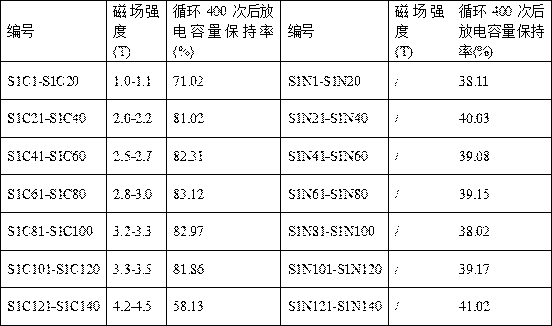Method for improving charging efficiency of secondary battery
A technology of secondary battery and charging efficiency, applied in the direction of secondary battery charging/discharging, secondary battery repair/maintenance, etc., can solve the problems of uneven reaction of active ingredients, low reaction efficiency, low charging efficiency, etc., and achieve stable combination. High performance, reduce loss and improve charging efficiency
- Summary
- Abstract
- Description
- Claims
- Application Information
AI Technical Summary
Problems solved by technology
Method used
Image
Examples
Embodiment 1
[0043] The commercially available Shenzhen Liyuan 2477 lithium-ion battery (a secondary lithium battery with a standard battery capacity of 180mAh) was selected as the subject of the test to carry out the technical solution test of the present invention. The Shenzhen Liyuan 2477 lithium-ion battery selected in this example was from the same batch A new unopened battery that has been stored for 7 months at the factory.
[0044] First, two symmetrical DC electromagnets are set outside the Shenzhen Liyuan 2477 lithium-ion battery, and the constant magnetic field generated by the two symmetrical DC electromagnets is used as the source magnetic field to act as a boost to the Shenzhen Liyuan 2477 lithium-ion battery. Magnetic field, which promotes the magnetic field to act between the positive and negative electrodes of the battery, and α is 90° (after calculating the divergence of the magnetic field, α is 86-94°), stabilizing the Shenzhen Liyuan 2477 lithium-ion battery and the sour...
Embodiment 2
[0051] The specific steps are the same as the battery samples numbered S1C61 to S1C80 in Example 1. The difference is that the battery model is changed to Shenzhen Yunkai LIR1220 battery (a secondary lithium battery with a standard battery capacity of 8mAh) as the test subject to carry out the technical solution test of the present invention. The LIR1220 battery used in this example is a new unopened battery of the same batch that has been stored for 11 months. And numbers S2C1 to S2C20 are used as samples for applying a promoting magnetic field, and numbers S1N1 to S1N20 are samples for not applying a promoting magnetic field, and the same test as the battery samples of the embodiment numbers S1C61 to S1C80 is carried out (16mA charge and discharge / 2C charge and discharge) .
[0052] Tested:
[0053] The average capacitance retention rate of the samples numbered S2C1 to S2C20 reached more than 83%, while the average capacitance retention rate of the samples numbered S1N1 to ...
Embodiment 3
[0055] The specific steps are the same as those of the battery samples numbered S1C61 to S1C80 in Example 1. The difference is that the promoting magnetic field is adjusted. In this embodiment, the promoting magnetic field is formed by combining the time-varying electromagnetic field of an electromagnet and the constant magnetic fields of three permanent magnets. , the magnetic field strength acting between the positive and negative poles of the battery is 2.8-3.5T, where α 1 =0°,α 2 30°, 45° and 90° respectively. And numbers S3C1 to S3C20 are used as samples with a boosting magnetic field applied, and numbers S3N1 to S3N20 are samples without a boosting magnetic field applied, and the same test as the battery samples with the numbers S1C61 to S1C80 in the embodiment is carried out (16mA charge and discharge / 2C charge and discharge) .
[0056] Tested:
[0057] The average capacitance retention rate of samples numbered S3C1 to S3C20 reached over 86%, while the average capaci...
PUM
| Property | Measurement | Unit |
|---|---|---|
| Magnetic field strength | aaaaa | aaaaa |
| Magnetic field strength | aaaaa | aaaaa |
Abstract
Description
Claims
Application Information
 Login to View More
Login to View More - R&D
- Intellectual Property
- Life Sciences
- Materials
- Tech Scout
- Unparalleled Data Quality
- Higher Quality Content
- 60% Fewer Hallucinations
Browse by: Latest US Patents, China's latest patents, Technical Efficacy Thesaurus, Application Domain, Technology Topic, Popular Technical Reports.
© 2025 PatSnap. All rights reserved.Legal|Privacy policy|Modern Slavery Act Transparency Statement|Sitemap|About US| Contact US: help@patsnap.com

